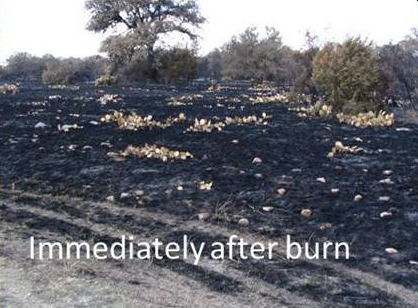Benefits of Prescribed Burning
-
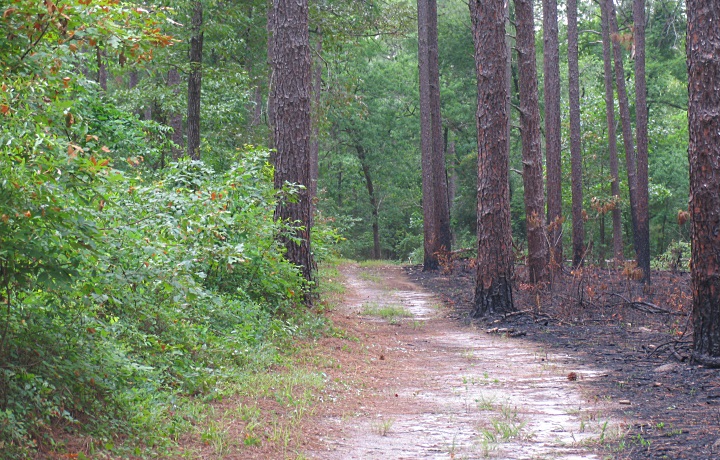
Burned and unburned longleaf pine forest
-
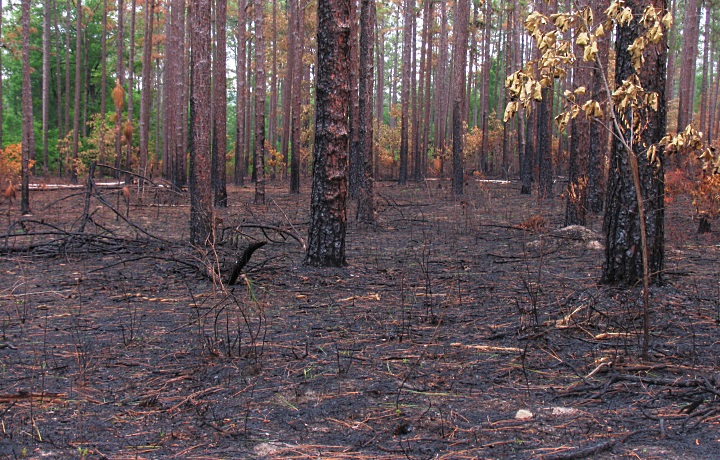
11 days after prescribed burn, Hitchcock Woods, Aiken County
(Note: new green growth already emerging) -
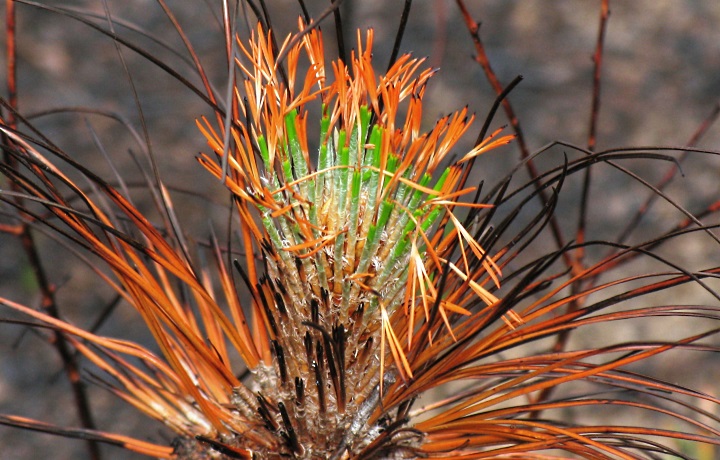
Longleaf Pine is highly adapted to fire
-
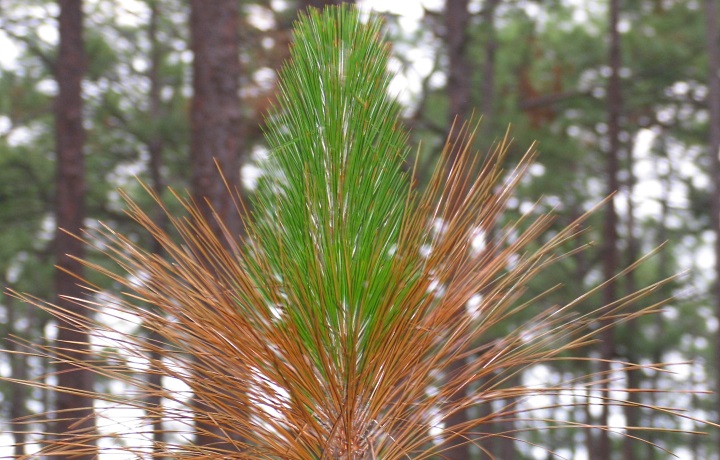
New growth emerges on young longleaf pine
-

Santee Coastal Reserve (Coastal Longleaf Pine Flatwoods), Charleston County
-

Brosnan Forest (Coastal Plain Longleaf Pine Flatwoods), Dorchester County
-
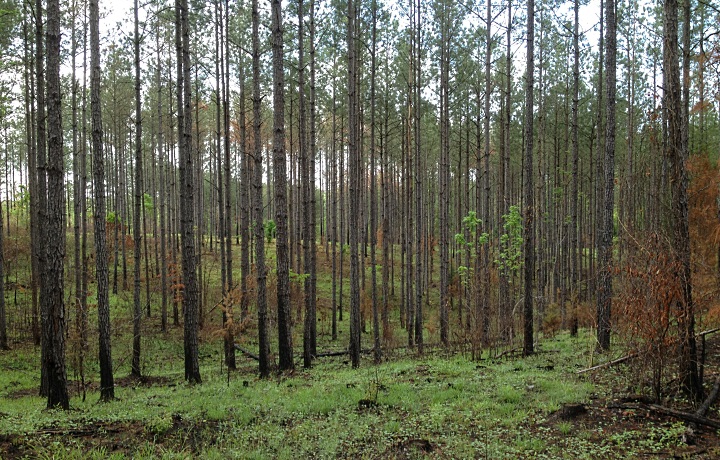
Stevens Creek HP (Piedmont Loblolly Pine Plantation), Edgefield County
- What is Prescribed Burning?
-
Prescribed Burning is the planned application of a controlled fire to forest, brush, or grassland vegetative fuels under specified environmental conditions and precautions which cause the fire to be confined to a predetermined area and allow accomplishment of the planned land management objectives; also known as "controlled" burning.
- How does Prescribed Burning differ from wildfire?
-
The term wildfire would apply to any unplanned fire occurring in a forest or grassland environment, or wildland. Wildfires can occur at any time, even when weather conditions would be unfavorable for prescribed burning, such as very hot, dry, and excessively windy days, when fire is difficult to control. Prescribed burning is also confused with the term "open burning", which generally relates to the burning of leaves, branches, and yard trimmings in a residential setting, or piled debris from land clearing operations.
- Why does DNR burn?
-
Prescribed burning is used to mimic the natural occurrence of fire in the woods, which has been an integral part of many North American ecosystems for thousands of years. The primary reasons for using prescribed fire are to control competing woody vegetation (shrubs and hardwood regeneration) and reduce fuel loading on the forest floor.
- How does burning help reduce the risk of wildfire?
-
Periodic burning eliminates most of the flammable fuels that accumulate on the forest floor, such as leaves, pine needles, limbs, downed logs, etc, rendering an area temporarily fire resistant (no fuel = no fire). As fuels then re-accumulate over time, the overall amount of fuel is much less, making the occurrence of unplanned wildfire much less intense and damaging, and easier to control. Prescribed burning also interrupts the continuity of the fuel layer, not only horizontally on the ground surface, but also vertically. As underbrush grows taller over time, a vertical fuel structure is developed, which can lead to surface wildfires climbing the fuel ladder and becoming disastrous crown fires.
- How does burning benefit wildlife and natural vegetation?
-
Woody vegetation such as shrubs and most hardwoods are generally not adapted to tolerate fire and are therefore killed back with the use of prescribed fire. The repeated use of fire over time can eliminate this woody vegetation from the understory of a forest stand, allowing native species of grasses and forbs to thrive in the absence of the woody competition. Native grasses and forbs are fire-adapted and highly responsive to fire, often resprouting in just a matter of a few days after a prescribed fire. Not only is the lush new green growth excellent forage for many species of wildlife, this herbaceous layer is also very diverse. Different flowering and seeding times for a wide variety of plants provides additional food sources directly for wildlife throughout the year. This wide variety of understory plants also serves host to different varieties of insects, another primary food source for many wildlife species. Along with the wide array of food sources, this native vegetation also provides much needed structure for ground nesting birds.
- What happens if a property is not burned?
-
The processes of natural succession will take place in the absence of fire or another disturbance. What may have once been a diverse herbaceous understory of grasses and forbs, will give way to woody shrubs and hardwood regeneration. Over longer time periods, these woody components will completely occupy the understory and eventually even replace the overstory canopy (which is often pine on upland sites in SC). The amount of flammable fuel on the forest floor will greatly increase, making the risk for wildfire much higher.
- I have a property near my home that is in need of
burning, why has it not been done? -
The overall need for prescribed burning in southern forests far outweighs the capacity of land managers to conduct those burns on a periodic basis. Prioritizing which areas get burned every year may include a variety of factors such as property ownership, size of the tract, prior burning history, and location. As urban and suburban areas continue to expand into the rural landscape, the smoke created from the use of fire becomes an increasing difficult factor to manage. Unfortunately, interactions with people and smoke can prevent a particular property from being managed with prescribed fire. This can lead to fuel loading problems in these wildland-urban interfaces, the very worst place for catastrophic wildfire occurrence.
- Where, when, and how much is burned each year by DNR?
-
SCDNR burns about 30,000-35,000 acres of forest land every year on their properties all over the state. The vast majority is conducted in upland pine forests, but there is some that takes place in fire-tolerant upland hardwood forests as well. Most of the burning occurs during the winter and spring months, starting in earnest in January and running through June. Burning is not specifically limited to these months though, and opportunities in the summer and fall are also taken in an effort to mimic natural fire, which would have occurred at all times of the year, when conditions presented themselves. Additionally, SCDNR burns 5,000-6,000 acres of agricultural lands each year, including dove fields, managed waterfowl impoundments, marsh, and other wildlife openings.
- Who does DNR partner with to burn?
-
SCDNR staff conduct much of the prescribed burning on their properties, particularly on larger tracts where staff and equipment are located on-site or nearby. SCDNR's primary partner in prescribed burning is the South Carolina Forestry Commission, who provide additional personnel and resources to increase the number of acres burned, on the limited number of suitable days, over the course of a burning season. SCDNR contracts with the SCFC for these services in much the same way as a private landowner would. SCDNR also utilizes private contractors to supplement the burning program in areas where SCDNR and SCFC staff are limited, and in certain instances, partners with organizations such as The Nature Conservancy where land-holdings have mutual interests.
- How often is a piece of property burned?
-
Upland pine forests are typically burned on a 2-3 year rotation, as that is the return interval that natural fire would have occurred in the southeast. Generally only a portion of any given property will be burned in a given year (depending on the size of the tract), thereby providing wildlife with a variety of burned vs. unburned habitat conditions. Mixed pine/hardwood and fire-tolerant upland hardwood forest may be burned less frequently on a 3-5 year rotation. A few selected locations may be burned annually or semi-annually if they have unique plant associations that are highly fire-dependent. In general, the faster the vegetation grows on a given site, the more frequently it would need to be burned.
- How do you determine what to burn and when?
-
Prioritizing particular parcels to burn depends on a number of factors such as the burning history and where that stand is in its particular burning rotation. Every attempt is made to keep priority stands on their regular rotation, whatever that may be. Stands that harbor unique fire-dependent plants or threatened and endangered wildlife species may be given higher priority. Beyond general prioritization, the determination of which area to burn on any given day is based on fuel conditions (load, moisture, arrangement) and weather conditions (relative humidity, atmospheric stability, temperature), including the speed and direction of the wind, which determines where associated smoke will be dispersed. Additionally, dormant season burning (winter) vs. growing-season burning (spring/summer) is given consideration as dormant season burning is more suited to fuel reduction and growing season burning is better for controlling hardwoods and promoting herbaceous vegetation.
- What do you hope to see on a plot of land after it
is burned? 1 year out? 5 years? -
Right after a burn is conducted, you would expect to see a blackened understory, with most of the smaller fuels having been consumed by the fire. Understory and midstory hardwoods and shrubs may not be fully consumed, but their foliage will be brown. In a pine stand, it is not unusual to even see some brown needles on the overstory trees. Pine trees are adapted to this heat-induced scorch of the needles, which will soon shed and be replaced with new green needles. Some of the larger fuels (logs, stumps) may not be fully consumed, or may continue to smolder on for several days after the fire.
While the purpose is to reduce the overall fuel load, a good prescribed burn will leave a small amount of the litter layer intact to protect the stability of the site and native seed bank. This is one of the differences when compared to a wildfire, which may burn a site down to bare mineral soil. Herbaceous vegetation will quickly begin to resprout, often in a matter of days, and a month or two into the next growing season, the site should be lush with fresh green vegetation. After a full year of regrowth, the native grasses and forbs will have completely occupied the site and many will have flowered and seeded. The skeletons of the hardwood vegetation that were killed by the fire may still remain, but they will begin to break down and fall onto the forest floor, becoming fuel for the next fire.
Repeating this process over time will clean this woody component up and result in a more herbaceous composition overall. Depending on the productivity of the site, the amount of woody vegetation before the fire, and the season of the fire, the shrub and hardwood layer will slowly begin to regrow in the understory over the next few years, hence the 2-3 year general burning rotation. If this woody vegetation is allowed to continue without being checked by another fire, the site will generally return to its pre-fire condition within 4-5 years.
Related Links
- South Carolina Forestry Commission
- South Carolina Prescribed Fire Council
- U.S. Forestry Service
- Smokey the Bear talks about the Benefits of Fire
- Fire Dependent Ecosystem with periodic fire (contains Flash Video)
- Fire Dependent Ecosystem without periodic fire (contains Flash Video)
- GoodFIRES.org
- Southern Group of State Foresters
- Texas A & M


